
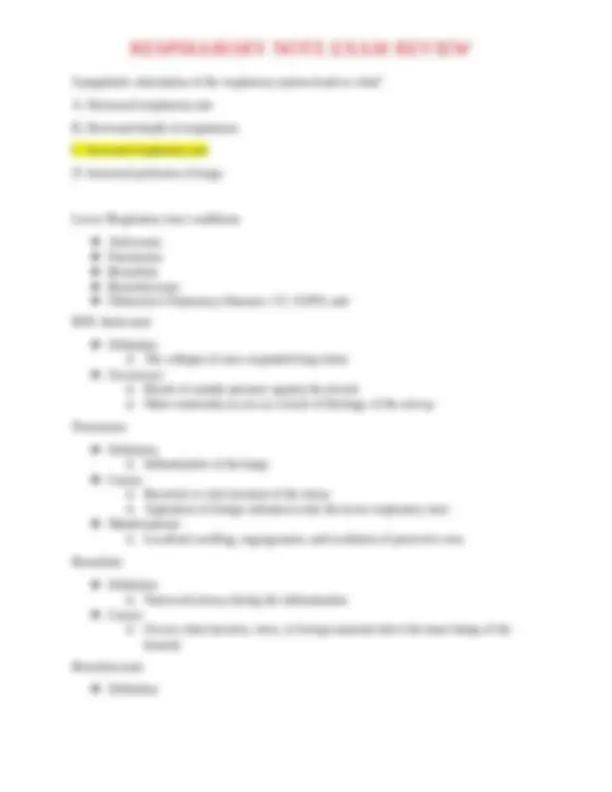
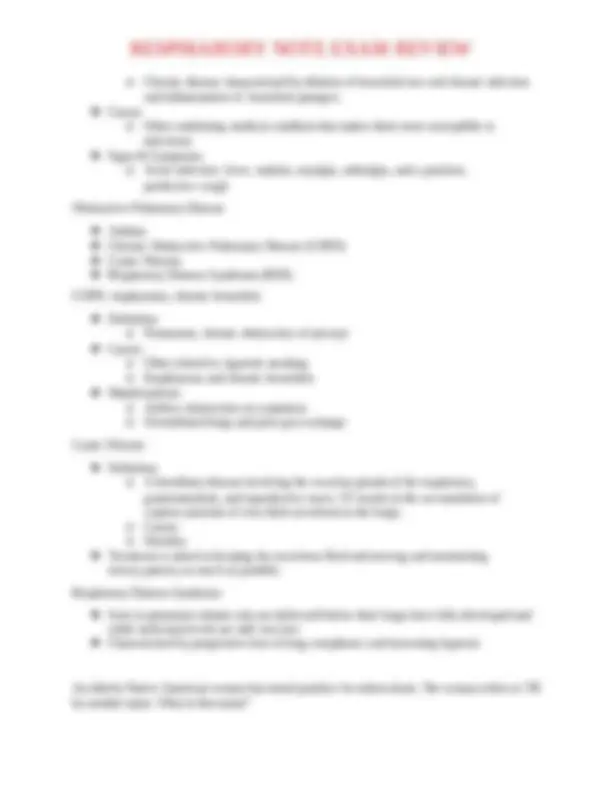
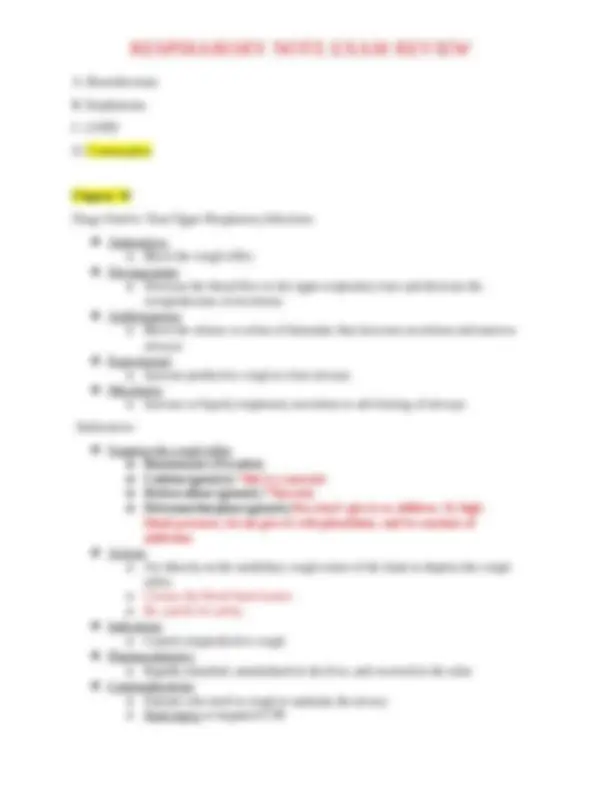
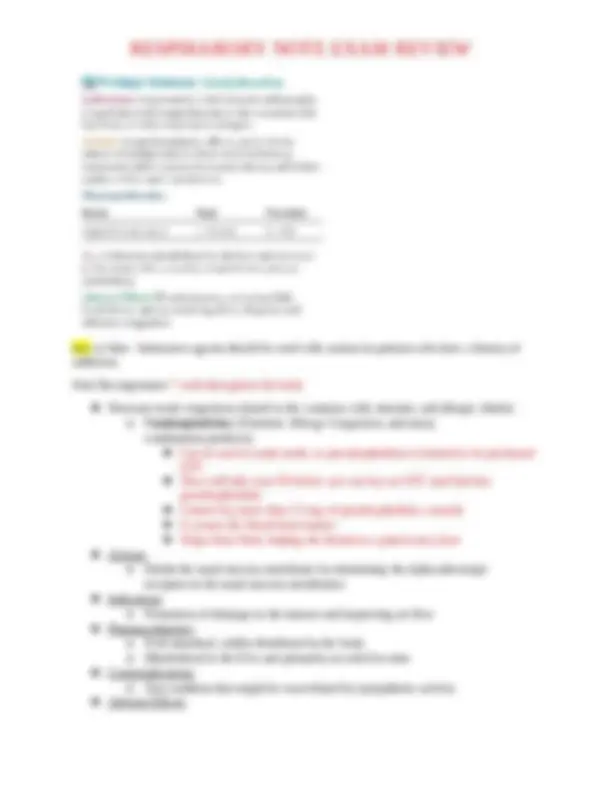
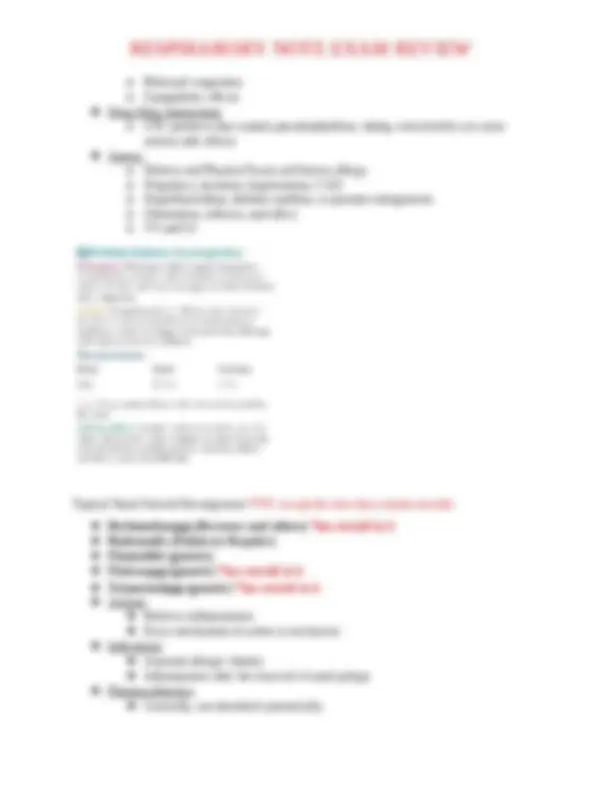
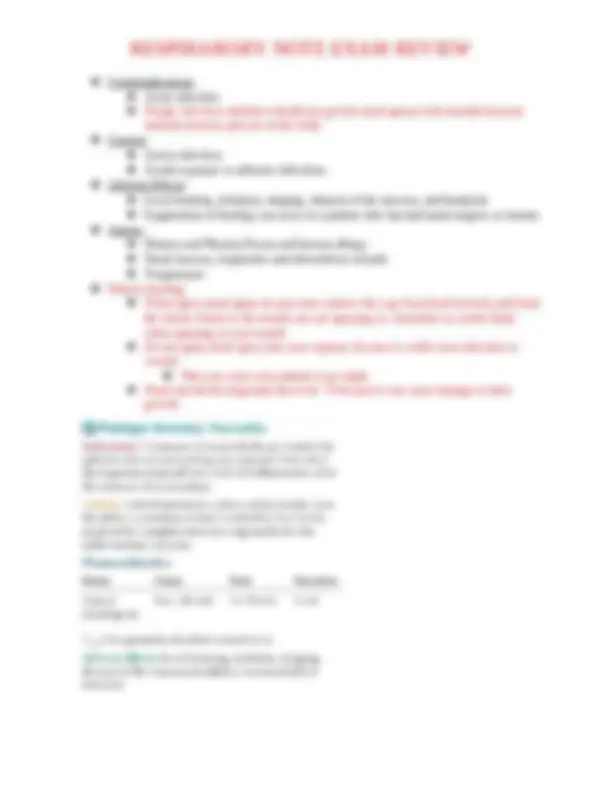
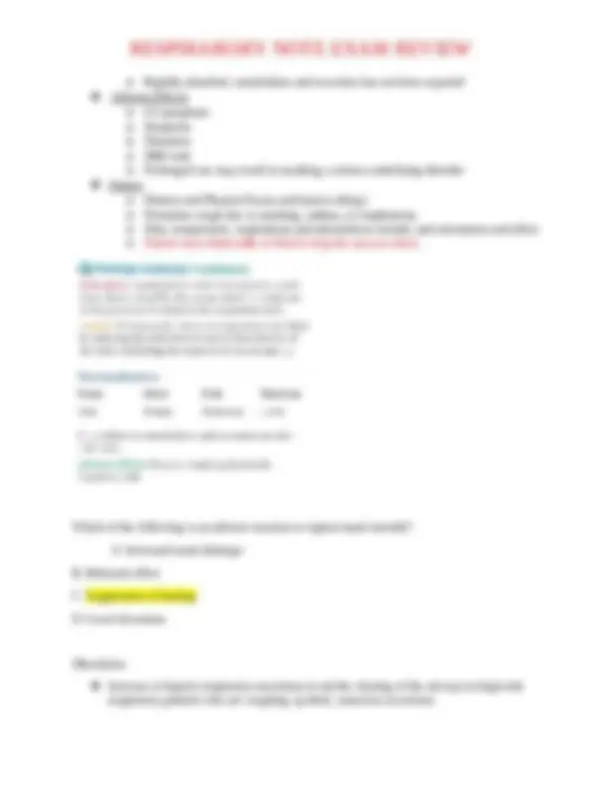
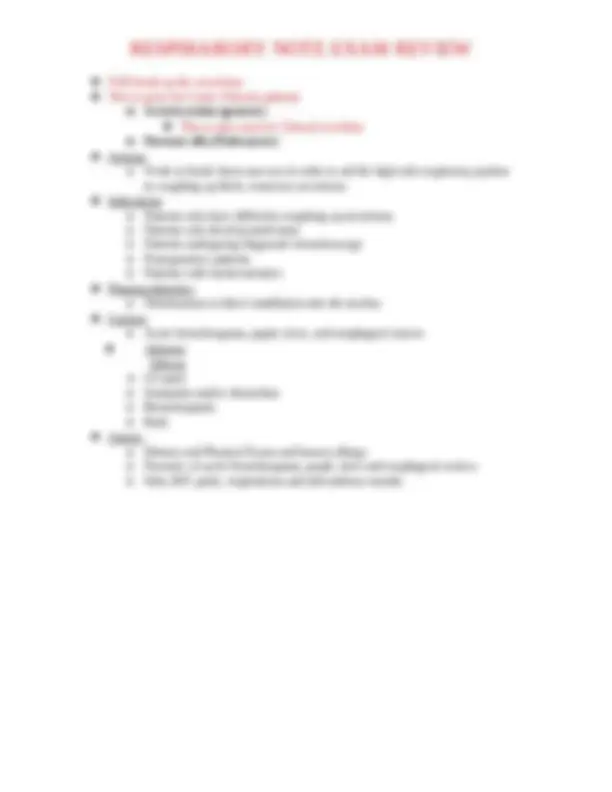
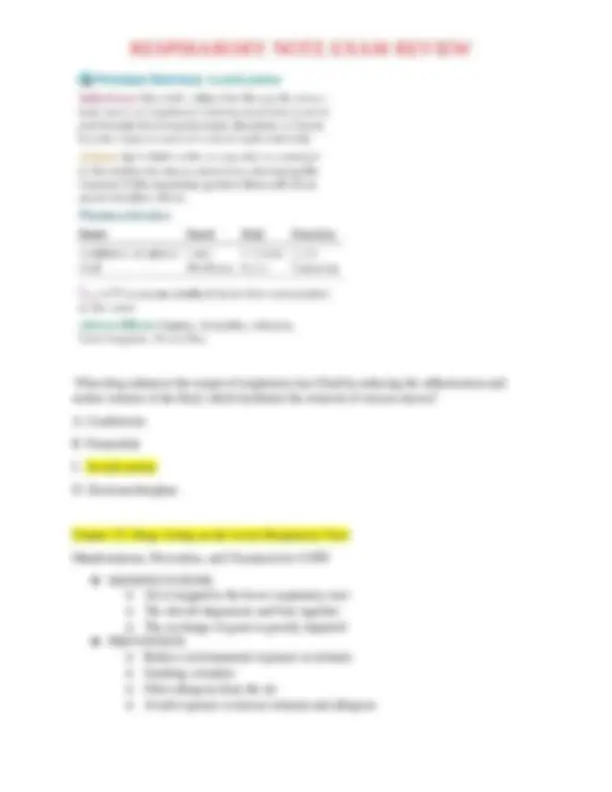
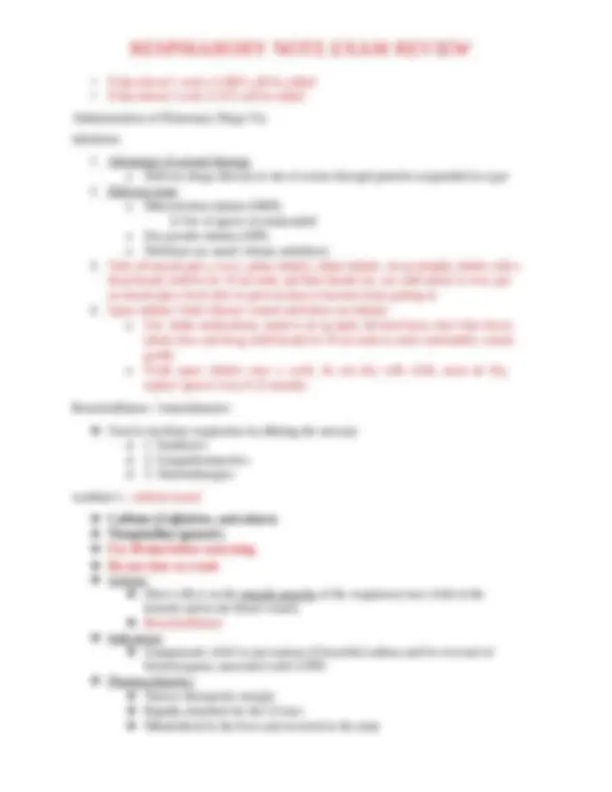
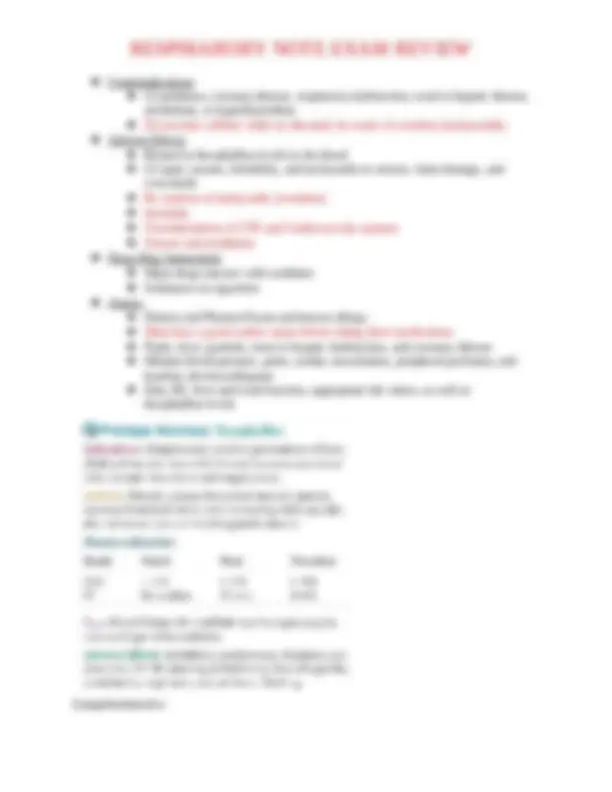
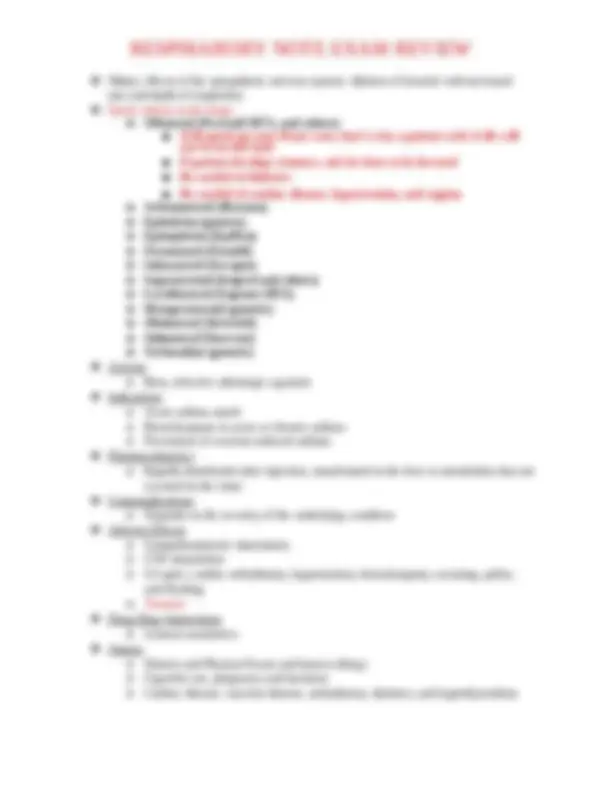
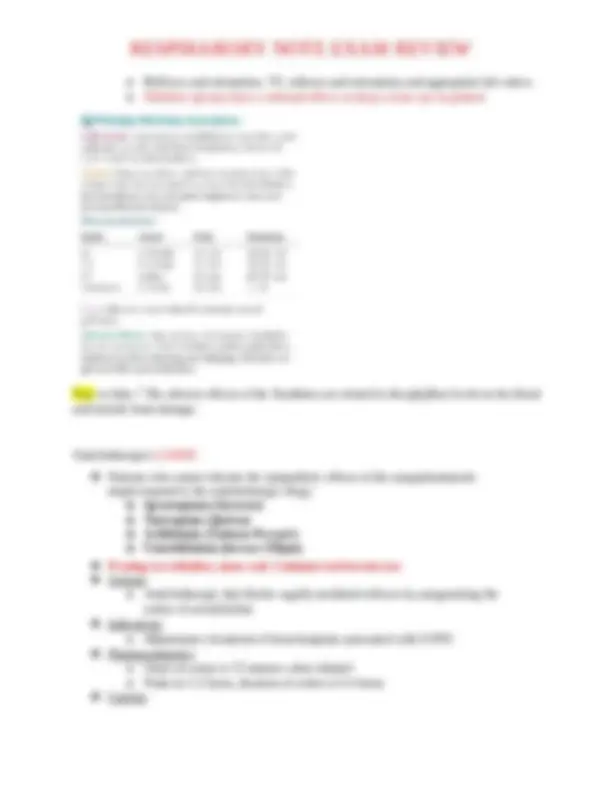
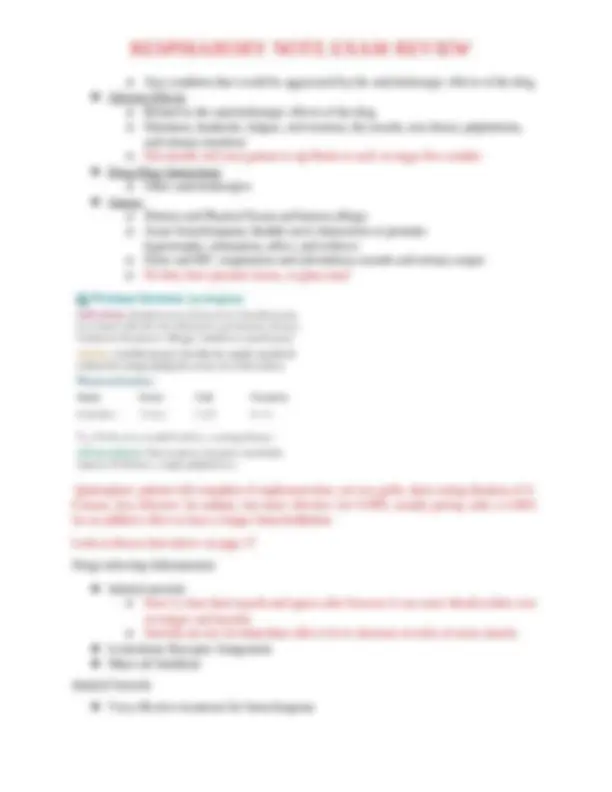
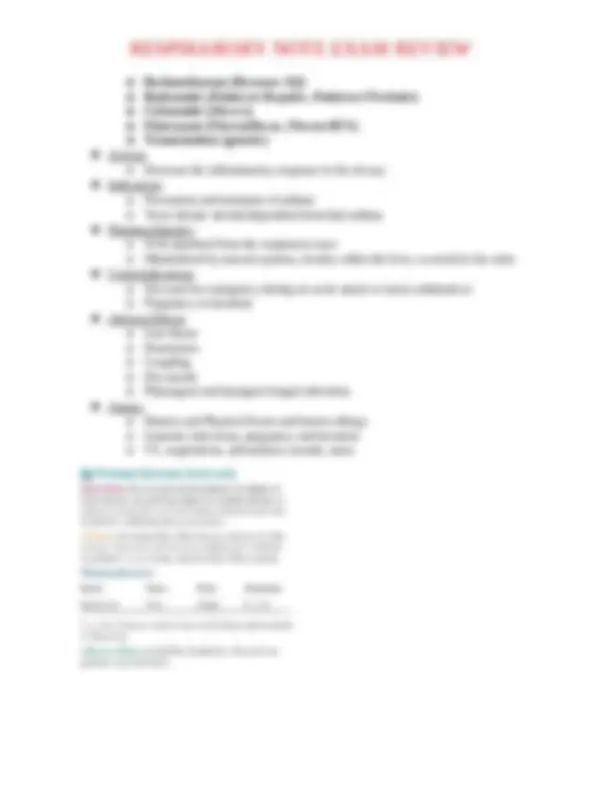
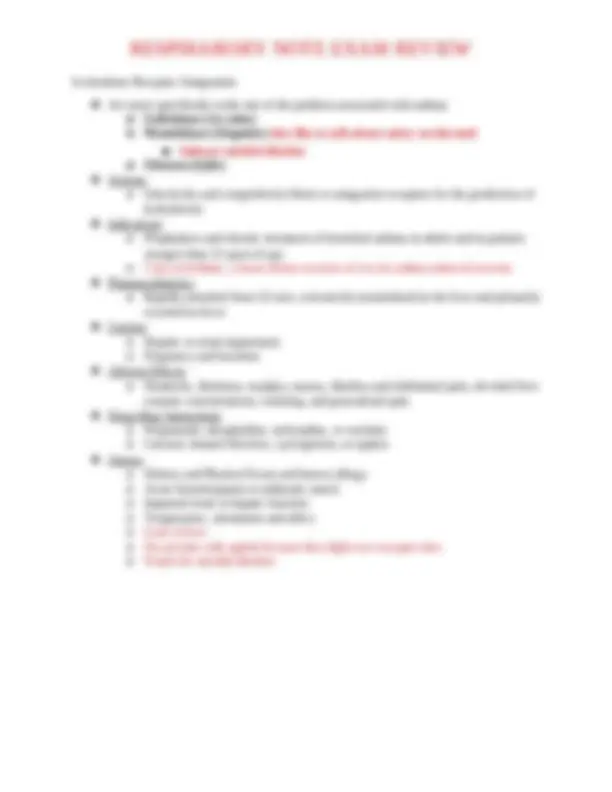
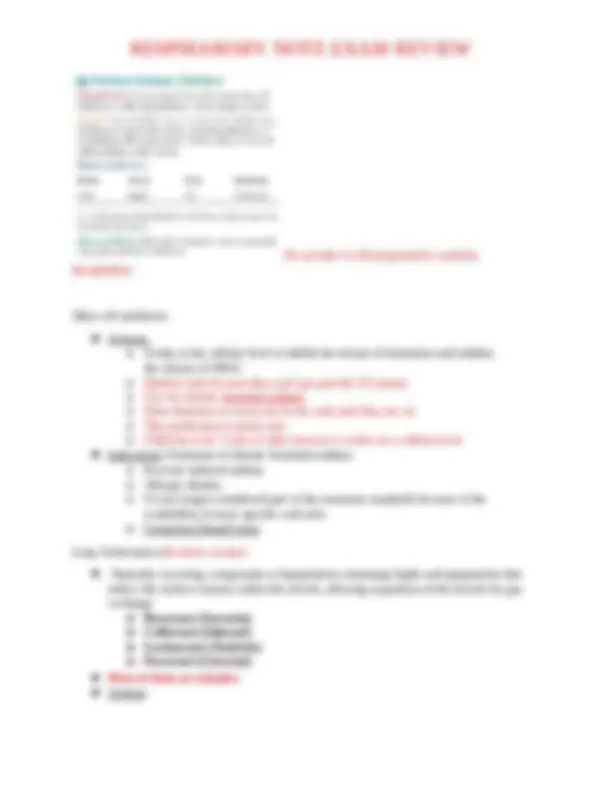
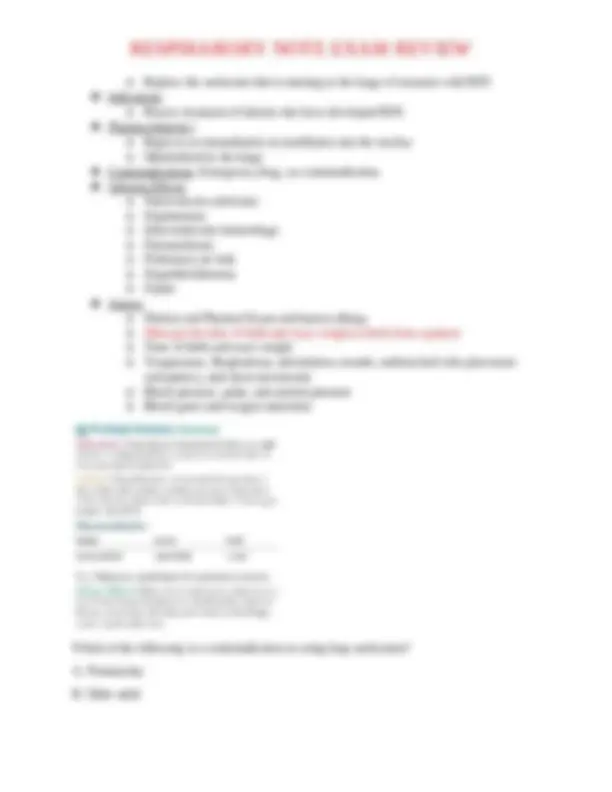
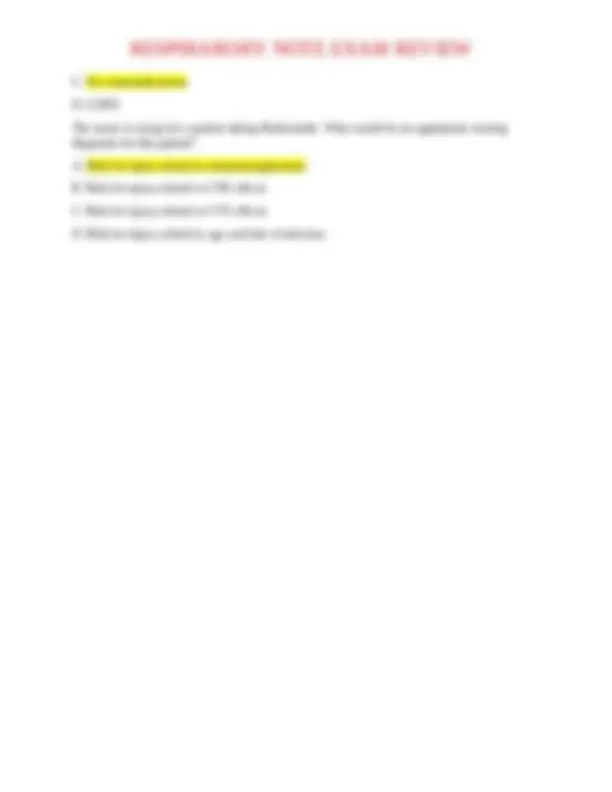


Study with the several resources on Docsity

Earn points by helping other students or get them with a premium plan


Prepare for your exams
Study with the several resources on Docsity

Earn points to download
Earn points by helping other students or get them with a premium plan
Community
Ask the community for help and clear up your study doubts
Discover the best universities in your country according to Docsity users
Free resources
Download our free guides on studying techniques, anxiety management strategies, and thesis advice from Docsity tutors
An overview of the anatomy of the upper respiratory system, including its components and functions. It also covers the protective features of the upper respiratory tract, cough and sneeze reflexes, and conditions that affect the upper respiratory tract. Additionally, the document discusses drugs used to treat upper respiratory infections, including antitussives, decongestants, antihistamines, expectorants, and mucolytics. It provides information on the actions, indications, pharmacokinetics, contraindications, cautions, adverse effects, and drug-drug interactions of these drugs.
Typology: Schemes and Mind Maps
1 / 27

This page cannot be seen from the preview
Don't miss anything!




















Chapter 53: Anatomy of the upper respiratory system ❖ Components o Upper respiratory tract o Lower respiratory tract ❖ Function o Brings oxygen into the body o Allows for the exchange of gases o Expels carbon dioxide and other waste products Protective features of the Upper Respiratory Tract ❖ Hairs filter the air ❖ Goblet cells produce mucus to trap material ❖ Cilia move the trapped material toward the throat for swallowing ❖ The blood supply close to the surface warms air and adds humidity to improve gas movement and gas exchange ❖ The cough and sneeze reflexes clear the airways Cough Reflex ❖ The walls of the trachea and conducting bronchi are highly sensitive to irritation. ❖ When receptors in the walls are stimulated, a central nervous system reflex is initiated. ❖ Cough causes air to be pushed through the bronchial tree under tremendous pressure, clearing the airway of foreign irritant. ❖ If they can cough they can usually swallow, it is the bodys natural way of getting rid of things that shouldn’t be there Sneeze reflex
❖ Initiated by receptors in the nasal cavity ❖ Forces foreign materials directly out of the system Layers of the Bronchial Tubes ❖ Cartilage ❖ Muscle ❖ Epithelial Cells True or false? The purpose of the cough and sneeze reflexes are to clear the airways. TRUE Lower respiratory Tract ❖ Composed of the smallest bronchioles and the alveoli ❖ Considered the functional unit of the lungs ❖ Gas exchange occurs in the alveoli – ventilation Components of the Respiratory Membrane and Gas exchange ❖ Gas exchange occurs at alveolar level. The alveolar sac holds the gas, allowing needed oxygen to diffuse across the respiratory membrane. It consists of the following: ❖ Capillary Endothelium ❖ Capillary Basement Membrane ❖ Interstitial Space ❖ Alveolar Basement Membrane ❖ Alveolar Epithelium ❖ Surfactant Layer Process of Respiration ❖ Controlled through the medulla in the central nervous system ❖ Depends on a balance between the sympathetic and parasympathetic systems ❖ Depends on a functioning muscular system Controls Over the Respiratory System ❖ Parasympathetic nerve stimulate the diaphragm contraction and inspiration ❖ Vagal stimulation leads to bronchoconstriction ❖ Sympathetic stimulation leads to increased rate and depth of respiration and dilation of the bronchi to allow free flow of air through the system Upper Respiratory Tract Conditions ❖ The Common Cold ❖ Seasonal Rhinitis ❖ Sinusitis ❖ Pharyngitis and Laryngitis
o Chronic disease characterized by dilation of bronchial tree and chronic infection and inflammation of bronchial passages. ❖ Causes o Often underlying medical condition that makes them more susceptible to infections ❖ Signs & Symptoms o Acute infection: fever, malaise, myalgia, arthralgia, and a purulent, productive cough Obstructive Pulmonary Disease ❖ Asthma ❖ Chronic Obstructive Pulmonary Disease (COPD) ❖ Cystic Fibrosis ❖ Respiratory Distress Syndrome (RDS) COPD: emphysema, chronic bronchitis ❖ Definition o Permanent, chronic obstruction of airways ❖ Causes o Often related to cigarette smoking o Emphysema and chronic bronchitis ❖ Manifestations o Airflow obstruction on expiration o Overinflated lungs and poor gas exchange Cystic Fibrosis ❖ Definition o A hereditary disease involving the exocrine glands of the respiratory, gastrointestinal, and reproductive tracts. CF results in the accumulation of copious amounts of very thick secretions in the lungs. o Causes o Heredity ❖ Treatment is aimed at keeping the secretions fluid and moving and maintaining airway patency as much as possible. Respiratory Distress Syndrome ❖ Seen in premature infants who are delivered before their lungs have fully developed and while surfactant levels are still very low ❖ Characterized by progressive loss of lung compliance and increasing hypoxia An elderly Native American woman has tested positive for tuberculosis. The woman refers to TB by another name. What is that name?
A. Bronchiectasis B. Emphysema C. COPD D. Consumption Chapter 54 Drugs Used to Treat Upper Respiratory Infections ❖ Antitussives o Block the cough reflex ❖ Decongestants o Decrease the blood flow to the upper respiratory tract and decrease the overproduction of secretions ❖ Antihistamines o Block the release or action of histamine that increases secretions and narrows airways ❖ Expectorants o Increase productive cough to clear airways ❖ Mucolytics o Increase or liquefy respiratory secretions to aid clearing of airways Antitussives ❖ Suppress the cough reflex o Benzonatate ( Tessalon **) o Codeine (generic) this is a narcotic o Hydrocodone (generic) Narcotic o Dextromethorphan (generic) 8we don’t give it to children <6, high blood pressure, do not give it with phenelzine, and be cautious of addiction ❖ Actions o Act directly on the medullary cough center of the brain to depress the cough reflex o Crosses the blood brain barrier o Be careful for safety ❖ Indications o Control nonproductive cough ❖ Pharmacokinetics o Rapidly absorbed, metabolized in the liver, and excreted in the urine ❖ Contraindications o Patients who need to cough to maintain the airway o Head injury or impaired CNS
o Xylometazoline ( Otrivin ) ❖ Actions o Sympathomimetic o Affects sympathetic nervous system to cause vasodilatation o Causing less inflammation of the nasal membrane ❖ Indications o Relieve the discomfort of nasal congestion that accompanies the common cold, sinusitis, and allergic rhinitis ❖ Pharmacokinetics o Generally, not absorbed systemically o Any portion of these topical decongestants that is absorbed is metabolized in the liver and excreted in the urine ❖ Contraindications o Lesion or erosion in the mucous membranes ❖ Caution o Any condition that might be exacerbated by sympathetic activity ❖ Adverse Effects o Local stinging and burning o Rebound congestion: because they use it too much ❖ Decongestant nasal spray can be addicting if used more than 3-5 days, not all nasal sprays ❖ Decongestant nasal spray can help improve nasal airway and breath better ❖ Nasal spray effects ware’s off quickly, causing it to be used too much, and leading to addicting o Sympathomimetic effects ❖ Drug-Drug Interactions o Cyclopropane or halothane ❖ Assess: o History and Physical Exam and known allergy o Glaucoma, hypertension, diabetes, thyroid disease, coronary disease, and prostate problems o Orientation and reflexes, VS and cardiac status o Respirations and adventitious lung sounds o Nasal mucous membrane and urinary status
true or false. Antitussive agents should be used with caution in patients who have a history of addiction. Oral Decongestants * work throughout the body ❖ Decrease nasal congestion related to the common cold, sinusitis, and allergic rhinitis o P seudoephedrine ( Triaminic Allergy Congestion , and many combination products) ❖ Can be used to make meth, so pseudoephedrine is limited to be purchased OTC ❖ They will take your ID before you can buy an OTC med that has pseudoephedrine ❖ Cannot buy more than 3.5 mg of pseudoephedrine a month ❖ It crosses the blood brain barrier ❖ Helps drain fluid, helping the dizziness a patient may have ❖ Actions o Shrink the nasal mucous membrane by stimulating the alpha-adrenergic receptors in the nasal mucous membranes ❖ Indications o Promotion of drainage in the sinuses and improving air flow ❖ Pharmacokinetics o Well absorbed, widely distributed in the body o Metabolized in the liver and primarily excreted in urine ❖ Contraindications o Any condition that might be exacerbated by sympathetic activity ❖ Adverse Effects
❖ Contraindications ❖ Acute infection ❖ People who have diabetes should not get the nasal sprays with steroids because steroids increase glucose in the body ❖ Caution ❖ Active infection ❖ Avoid exposure to airborne infections ❖ Adverse Effects ❖ Local burning, irritation, stinging, dryness of the mucosa, and headache ❖ Suppression of healing can occur in a patient who has had nasal surgery or trauma ❖ Assess: ❖ History and Physical Exam and known allergy ❖ Nasal mucosa, respiration and adventitious sounds ❖ Temperature ❖ Patient teaching ❖ When spray nasal spray in your nose remove the cap, lean head forward, pull back the cheek closest to the nostril you are spraying in. remember to switch hand when spraying in your nostril ❖ Do not spray nasal spray into your septum, because it could cause infection or wound ❖ This can cause your patient to go septic ❖ Nasal steroid decongestant has to be >4 because it can cause damage to their growth
Antihistamines ❖ Relieve respiratory symptoms and treat allergies ❖ First-generation and second generation antihistamines include: o Brompheniramine ( J-Tan ) o Carbinoxamine ( Histex , Palgic ) o Chlorpheniramine( Aller-Chlor ) and many others o See table 54. o Allegra is still iffy ❖ Actions o Selectively block the effects of histamine at the histamine-1 receptor sites, decreasing the allergic response ❖ We release histamine when we are having allergic reactions/ allergies o Anticholinergic and antipruritic effects ❖ Indications o Seasonal and perennial allergic rhinitis, allergic conjunctivitis, uncomplicated urticaria, and angioedema ❖ Pharmacokinetics o Well absorbed, metabolized in the liver, excreted in urine and feces ❖ Contraindications o Pregnancy and lactation ❖ Caution o Renal or hepatic impairment o History of arrhythmias ❖ Adverse Effects o Drowsiness and sedation o Anticholinergic effects o Blurred vision o May increase appetite and weight for long periods of time o Headache o Nasua o Heartburn o Dry mouth o Motion sickness o EPS ❖ Drug-Drug Interactions o Vary based on the drug ❖ Assess: o History and Physical Exam and known allergy o Pregnancy or lactation; and prolonged QT interval, renal or hepatic impairment o Skin, orientation, affect, and reflexes o Respirations and adventitious sounds
o Rapidly absorbed, metabolism and excretion has not been reported ❖ Adverse Effects o GI symptoms o Headache o Dizziness o Mild rash o Prolonged use may result in masking a serious underlying disorder ❖ Assess: o History and Physical Exam and known allergy o Persistent cough due to smoking, asthma, or emphysema o Skin, temperature, respirations and adventitious sounds, and orientation and affect o Patient must drink a lot of fluid to help the mucous drain Which of the following is an adverse reaction to topical nasal steroids? A. Increased nasal drainage B. Rebound effect C. Suppression of healing D. Local ulceration Mucolytics ❖ Increase or liquefy respiratory secretions to aid the clearing of the airways in high-risk respiratory patients who are coughing up thick, tenacious secretions
❖ Will break up the secretions ❖ This is great for Cystic Fibrosis patients o Acetylcysteine (generic) ❖ This is also used for Tylenol overdose o Dornase alfa ( Pulmozyme ) ❖ Actions o Work to break down mucous in order to aid the high-risk respiratory patient in coughing up thick, tenacious secretions ❖ Indications o Patients who have difficulty coughing up secretions o Patients who develop atelectasis o Patients undergoing diagnostic bronchoscopy o Postoperative patients o Patients with tracheostomies ❖ Pharmacokinetics o Nebulization or direct instillation into the trachea ❖ Caution o Acute bronchospasm, peptic ulcer, and esophageal varices ❖ Adverse Effects o GI upset o Stomatitis and/or rhinorrhea o Bronchospasm o Rash ❖ Assess: o History and Physical Exam and known allergy o Presence of acute bronchospasm, peptic ulcer and esophageal varices o Skin, B/P, pulse, respirations and adventitious sounds
o Open the conducting airways through muscular bronchodilation o Decrease the effects of inflammation on the airway lining Adult Respiratory Distress Syndrome ❖ Characteristics o Progressive loss of lung compliance and increasing hypoxia ❖ Causes o Cardiovascular collapse; major burns; severe trauma; rapid depressurization ❖ Treatment o Reversal of the underlying cause combined with ventilatory support Principles of Asthma Pharmacotherapy
❖ Salmeterol Xinafoate-Serevent Diskus-Exercise induced asthma ❖ Arformoterol Tartrate-Brovana-only for COPD ❖ Formoterol (inhalation sol)-Perforomist-only for COPD ❖ Olodaterol-Striverdi Respimat-COPD ❖ Budesonide with Formoterol-Symbicort-Asthma ❖ Fluticasone Furoate, umeclidinium, and Vilanterol-Trelegy Ellipta-COPD ❖ Fluticasone Propionate & Salmeterol-AirDuo Respiclick/Advair ❖ Fluticasone Furoate & Vilanterol-Breo Ellipta-COPD and Asthma ❖ Glycopyrrolate/Formoterol Fumarate-Bevespi Aerosphere-COPD ❖ Indacaterol/Glycopyrrolate-Utibron Neohaler-COPD ❖ Mometasone with Formoterol-Dulera- Asthma ❖ Tiotropium and Olodaterol-Stiolto Respimat-COPD ❖ Umeclidinium and Vilanterol-Anoro Ellipta-COPD Asthma (bronchoconstriction)- we are opening up the airway
❖ Contraindications ❖ GI problems, coronary disease, respiratory dysfunction, renal or hepatic disease, alcoholism, or hyperthyroidism ❖ Do not take caffeine while on this med; be aware of overdose (tachycardia) ❖ Adverse Effects ❖ Related to theophylline levels in the blood ❖ GI upset, nausea, irritability, and tachycardia to seizure, brain damage, and even death ❖ Be cautious of tachycardic (overdose) ❖ Insomnia ❖ Overstimulation of CNS and Cardiovascular systems ❖ Seizure and arrythmias ❖ Drug-Drug Interactions ❖ Many drugs interact with xanthines ❖ Substances in cigarettes ❖ Assess: ❖ History and Physical Exam and known allergy ❖ Must have a good cardiac status before taking these medications ❖ Peptic ulcer, gastritis, renal or hepatic dysfunction, and coronary disease ❖ Monitor blood pressure, pulse, cardiac auscultation, peripheral perfusion, and baseline electrocardiogram ❖ Skin, BS, liver and renal function, appropriate lab values, as well as theophylline levels Sympathomimetics
❖ Mimic effects of the sympathetic nervous system: dilation of bronchi with increased rate and depth of respiration ❖ Quick release in the lungs o Albuterol ( Proventil HFA , and others) ▪ Will speed up your Heart rate; that’s why a patient with A-fib will not be on this med ▪ If patient develops tremors, ask for dose to be lowered ▪ Be careful of diabetes ▪ Be careful of cardiac disease, hypertension, and angina o Arformoterol ( Brovana ) o Ephedrine (generic) o Epinephrine (EpiPen) o Formoterol (Foradil) o Indacaterol (Arcapta) o Isoproterenol (Isuprel and others) o Levalbuterol (Xopenex HFA) o Metaproterenol (generic) o Olodaterol (Striverdi) o Salmeterol (Serevent) o Terbutaline (generic) ❖ Actions o Beta 2 selective adrenergic agonists ❖ Indications o Acute asthma attack o Bronchospasm in acute or chronic asthma o Prevention of exercise-induced asthma ❖ Pharmacokinetics o Rapidly distributed after injection, transformed in the liver to metabolites that are excreted in the urine ❖ Contraindications o Depends on the severity of the underlying condition ❖ Adverse Effects o Sympathomimetic stimulation o CNS stimulation o GI upset, cardiac arrhythmias, hypertension, bronchospasm, sweating, pallor, and flushing o Tremors ❖ Drug-Drug Interactions o General anesthetics ❖ Assess: o History and Physical Exam and known allergy o Cigarette use, pregnancy and lactation o Cardiac disease, vascular disease, arrhythmias, diabetes, and hyperthyroidism